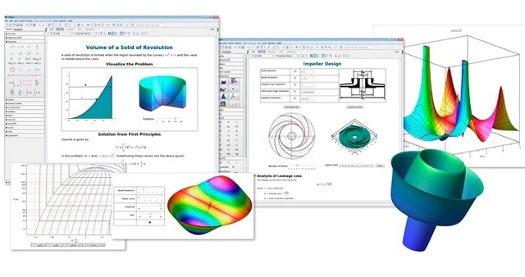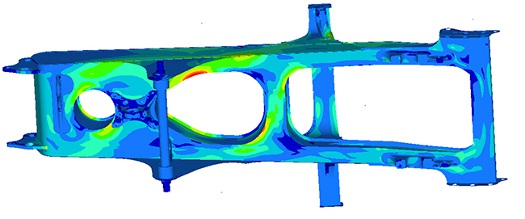 |
| February 27, 2018 | Volume 14 Issue 08 |
Designfax weekly eMagazine
Archives
Partners
Manufacturing Center
Product Spotlight
Modern Applications News
Metalworking Ideas For
Today's Job Shops
Tooling and Production
Strategies for large
metalworking plants
Construction truck design evolves at Hitachi using modern calculation management

In the current climate of industrial trucking products, truck manufacturing companies are striving to improve their products in more efficient ways than ever. These improvements can come in many forms, but in an industry of expensive prototypes and stiff competition, it is critical to find innovations that fit within tight margins, fast development cycles, and that deliver guaranteed reliability in the field. Regardless of the particular innovation, it will require some amount of careful calculations to ensure that the concept is feasible.
The engineering department at Hitachi Construction Truck Manufacturing (HTM) is taking steps to improve their rigid-frame hauling truck design through improving their analysis tools. The company has a history of using spreadsheet programs and older coding languages as a means to solve some engineering problems. While sometimes sufficient, these legacy approaches to managing intellectual company property can end up introducing redundancies and slowdowns in a variety of ways during a design process. The engineering department at HTM decided to gradually implement the use of Maple in several key areas to help speed development and reduce the risk of errors from manually handling calculations across many tools. Maple is math software that combines a super-powerful math engine with an interface that makes it extremely easy to analyze, explore, visualize, and solve mathematical problems.

Maple makes it easy to analyze, explore, visualize, and solve mathematical problems.
During typical analysis tasks at HTM, engineers use specific mathematics to work through design concepts, model their kinematic behavior, and analyze their structural integrity over time. In the truck's initial design stage, HTM has historically used some developed spreadsheet programs, but has recently moved to Maple to reduce the chance of errors and improve calculation efficiency. In addition, Maple has been adopted to optimize design parameters throughout the truck design process. "Using Maple can make calculations more efficient than using spreadsheets," said Dr. Shen, a senior manager of the technical analysis group, when explaining his past experience using spreadsheet tools for analysis work. Using Maple, HTM engineers can set up their analysis with an intuitive math input and use built-in functions to automatically solve and simplify work, reducing many of the possible errors they had associated with traditional, manual effort.
The rigid frames developed at HTM must support massive payloads ranging up to almost 300 tons. To make sure these frames are suitable for the job, HTM uses finite element analysis (FEA) to investigate the life of welded joints, helping to determine the required size of each weld. While FEA is a powerful tool, it can be very resource intensive, slowing down critical aspects of design analysis. Using Maple, HTM engineers perform initial stress estimations that give them a much better sense of their design before spending large amounts of time doing FEA iterations. With a better starting point, the FEA work is already honed way beyond rough approximations, so it can arrive at accurate solutions much quicker.

Performing FEA work is often very time and resource intensive. By using Maple, Dr. Shen of HTM is able to quickly approximate material stresses and use FEA to perform only the final leg of analysis.
In addition to improving the analysis capabilities of HTM, engineers are also beginning to integrate Maple into the reports they must regularly create for records. In the past, these reports would be an entirely different task, and any necessary mathematics would be inserted as screenshots, creating a break between the actual analysis and the report itself. With Maple, the documentation interface offers all of the features necessary for professional reports, and the mathematics involved are live, allowing updates to be reflected immediately across the entire document. Although still in the beginning phases, HTM engineers can now use Maple as a means to easily create reports from their pre-existing analysis work. As time goes on, this will allow engineers to create a live connection between their analysis work and their reporting, ensuring that future changes are reflected across all the relevant documents at hand.
By adopting Maple as a tool for calculation management, HTM is joining the growing number of organizations that are treating their engineering calculations as an essential company asset. Responding to an increasingly competitive market, HTM is finding success by reducing the many sources of inefficiencies caused by legacy calculation tools. The success that HTM is finding with Maple is the result of treating calculations as a structured asset, ensuring they are created, reused, and distributed with care and attention. The migration from old techniques still continues, but HTM engineers are already seeing the benefits of adopting Maple for a variety of tasks that were once performed in older, general-purpose tools. With proper calculation management tools in place, HTM is creating a powerful, efficient toolset that reduces development risk and gets their products to market faster.
To learn more, watch this webinar recording.
Source: Maplesoft
Published February 2018
Rate this article
View our terms of use and privacy policy
